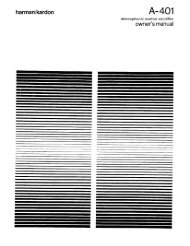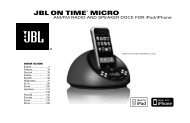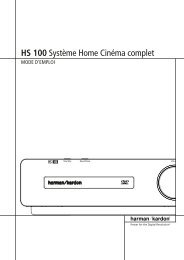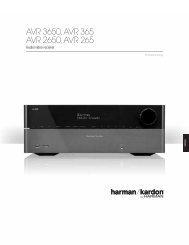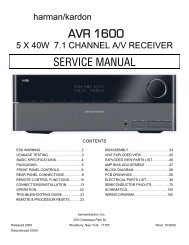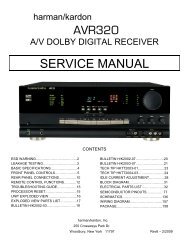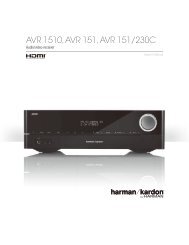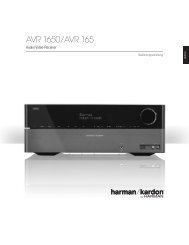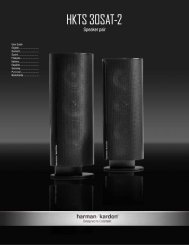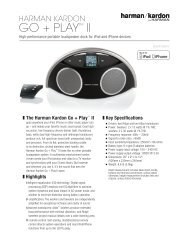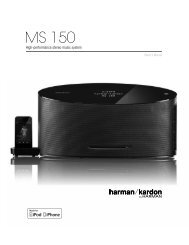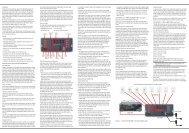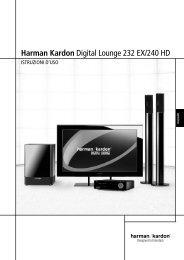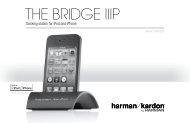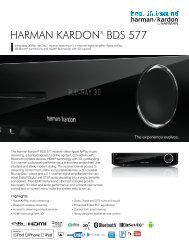HKTS 7 OM - Harman Kardon
HKTS 7 OM - Harman Kardon
HKTS 7 OM - Harman Kardon
Create successful ePaper yourself
Turn your PDF publications into a flip-book with our unique Google optimized e-Paper software.
SAFETY INFORMATION<br />
Read First! Important Safety Precautions!<br />
CAUTION<br />
RISK OF ELECTRIC SHOCK<br />
DO NOT OPEN<br />
CAUTION: To prevent electric shock,<br />
do not use this (polarized) <br />
plug with an extension cord, <br />
receptacle or other outlet <br />
unless the blades can <br />
be fully inserted to <br />
prevent blade exposure.<br />
<br />
The lightning flash with arrowhead symbol,<br />
within an equilateral triangle, is intended to<br />
alert the user to the presence of uninsulated<br />
“dangerous voltage” within the product’s<br />
enclosure that may be of sufficient magnitude to constitute a<br />
risk of electric shock to persons.<br />
The exclamation point within an equilateral<br />
triangle is intended to alert the user to the<br />
presence of important operating and<br />
maintenance (servicing) instructions in the<br />
literature accompanying the appliance.<br />
1. Read these instructions.<br />
2. Keep these instructions.<br />
3. Heed all warnings.<br />
4. Follow all instructions.<br />
5. Do not use this apparatus near water.<br />
6. Clean only with a dry cloth.<br />
7. Do not block any ventilation openings. Install in<br />
accordance with the manufacturer’s instructions.<br />
8. Do not install near any heat sources such as radiators,<br />
heat registers, stoves or other apparatus (including<br />
amplifiers) that produce heat.<br />
9. Do not defeat the safety purpose of the polarized<br />
or grounding-type plug. A polarized plug has two<br />
blades with one wider than the other. A groundingtype<br />
plug has two blades and a third grounding<br />
prong. The wide blade or the third prong are provided<br />
for your safety. If the provided plug does not fit into<br />
your outlet, consult an electrician for replacement of<br />
the obsolete outlet.<br />
10. Protect the power cord from being walked on or<br />
pinched, particularly at plugs, convenience receptacles<br />
and the point where they exit from the apparatus.<br />
11. Only use attachments/accessories specified by<br />
the manufacturer.<br />
12. Use only with the cart, stand, tripod,<br />
bracket or table specified by the manufacturer<br />
or sold with the apparatus.<br />
When a cart is used, use caution when<br />
moving the cart/apparatus combination to avoid injury<br />
from tip-over.<br />
13. Unplug this apparatus during lightning storms or<br />
when unused for long periods of time.<br />
14. Refer all servicing to qualified service personnel.<br />
Servicing is required when the apparatus has been<br />
damaged in any way, such as power-supply cord or<br />
plug is damaged, liquid has been spilled or objects<br />
have fallen into the apparatus, the apparatus has been<br />
exposed to rain or moisture, does not operate normally,<br />
or has been dropped.<br />
15. Do not use attachments not recommended by<br />
the product manufacturer, as they may cause hazards.<br />
16. This product should be operated only from the<br />
type of power source indicated on the marking label.<br />
If you are not sure of the type of power supply to<br />
your home, consult your product dealer or local<br />
power company. For products intended to operate<br />
from battery power, or other sources, refer to the<br />
operating instructions.<br />
17. If an outside antenna or cable system is connected<br />
to the product, be sure the antenna or cable system<br />
is grounded so as to provide some protection against<br />
voltage surges and built-up static charges. Article 810<br />
of the National Electrical Code, ANSI/NFPA 70, provides<br />
information with regard to proper grounding<br />
of the mast and supporting structure, grounding of<br />
the lead-in wire to an antenna discharge unit, size<br />
of grounding conductors, location of antennadischarge<br />
unit, connection to grounding electrodes,<br />
and requirements for the grounding electrode.<br />
See Figure 1.<br />
Figure 1.<br />
Example of Antenna Grounding as per<br />
National Electrical Code ANSI/NFPA 70<br />
18. An outside antenna system should not be located<br />
in the vicinity of overhead power lines or other electric<br />
light or power circuits, or where it can fall into such<br />
power lines or circuits. When installing an outside<br />
antenna system, extreme care should be taken to<br />
keep from touching such power lines or circuits, as<br />
contact with them might be fatal.<br />
19. Do not overload wall outlets, extension cords, or<br />
integral convenience receptacles, as this can result in<br />
a risk of fire or electric shock.<br />
20. Never push objects of any kind into this product<br />
through openings, as they may touch dangerous voltage<br />
points or short-out parts that could result in a fire<br />
or electric shock. Never spill liquid of any kind on the<br />
product.<br />
21. Do not attempt to service this product yourself, as<br />
opening or removing covers may expose you to dangerous<br />
voltage or other hazards. Refer all servicing to<br />
qualified service personnel.<br />
22. When replacement parts are required, be sure<br />
the service technician has used replacement parts<br />
specified by the manufacturer or that have the same<br />
characteristics as the original part. Unauthorized substitutions<br />
may result in fire, electric shock or other<br />
hazards.<br />
23. Upon completion of any service or repairs to this<br />
product, ask the service technician to perform safety<br />
checks to determine that the product is in proper<br />
operating condition.<br />
24. The product should be mounted to a wall or<br />
ceiling only as recommended by the manufacturer.<br />
Antenna Lead-In Wire<br />
Ground Clamp<br />
Antenna Discharge Unit (NEC Section 810-20)<br />
Grounding Conductors (NEC Section 810-21)<br />
Electric Service Equipment<br />
Ground Clamps<br />
Power Service Grounding Electrode System<br />
(NEC Art 250, Part H)<br />
SAFETY INFORMATION 3



